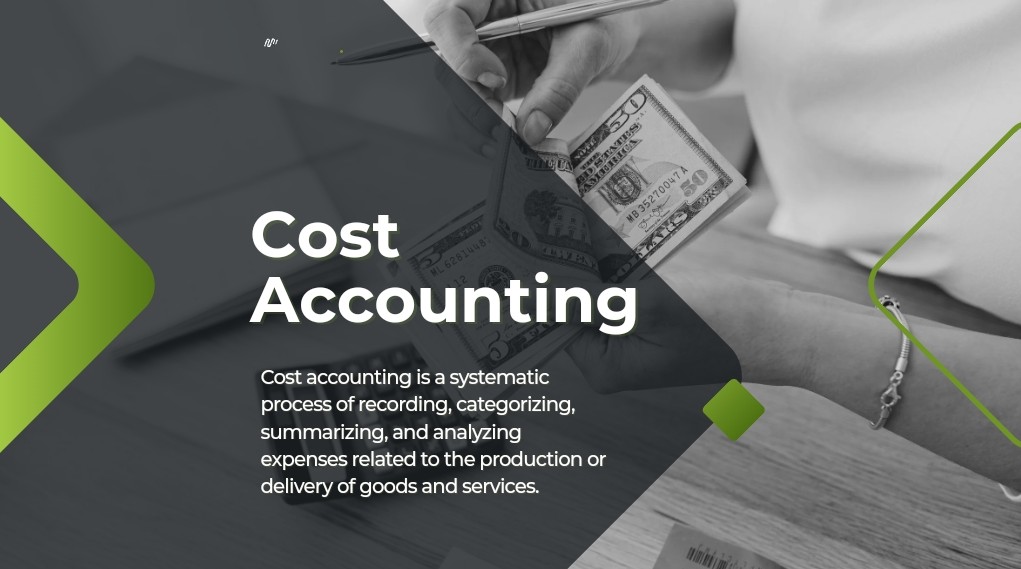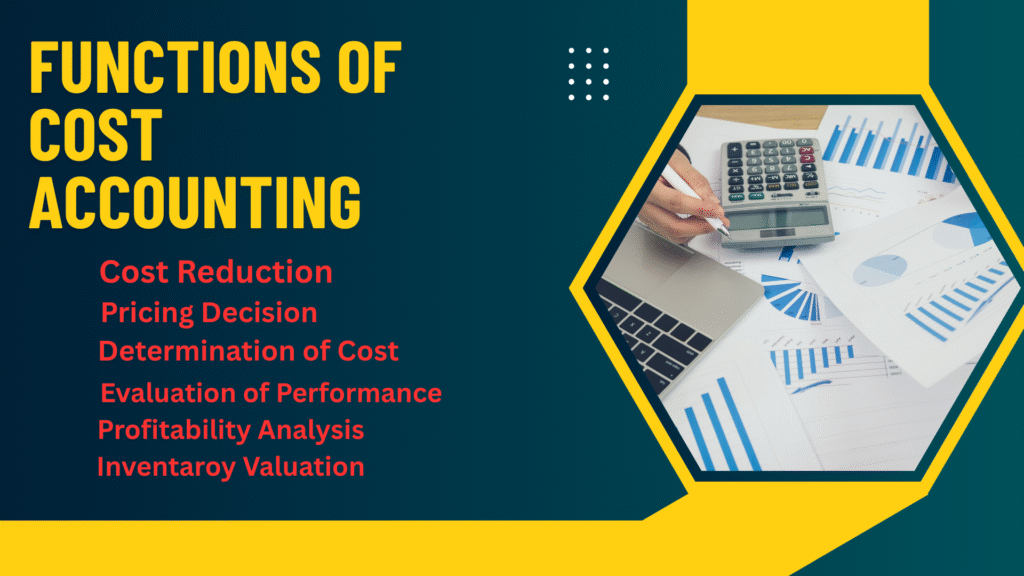In this blog you are going to learn Cost Accounting, Types of Cost Accounting and Functions of Cost Accounting.
What is Cost Accounting ?

Cost accounting is a systematic process of recording, categorizing, summarizing, and analyzing expenses related to the production or delivery of goods and services.
It involves gathering and analyzing financial data to determine the costs of various business activities, allowing managers to make more informed decisions that improve efficiency and profitability.
In simple words we can say that, Its primary purpose is to offer management with exact cost data that may be used for decision-making, cost control, and performance evaluation.
The primary goal of cost accounting is to show business owners where the company may improve its profitability. Cost accounting is also often used for internal management, hence no special rules apply.
Cost accounting provides greater cost control by detecting inefficiencies and successfully controlling production expenses. Cost accounting method is used to analyze the expenses of all manufacturing aspects.
What is Cost Accountent ?
A cost accountant is a professional in finance that studies a company’s production costs, or the money spent on manufacturing items or providing services.
Cost accountants are in charge of implementing, managing, and providing input on cost tracking.
Cost accountent helps in documentation, presentation, and analysis of manufacturing costs. They monitor all variable and fixed expenses to ensure that output corresponds to the product price.They also helps in management to make future decisions based on financial projections and manufacturing progress.
Types of Cost Accounting
1. Marginal Costing
Marginal costing is a Cost Accounting technique that assigns a variable cost to each unit of production and a fixed cost to all production activities combined.
Variable costs are those that change with production, such as raw materials and labor.
The fixed costs do not vary. By assigning fixed costs to all units of output, marginal costing provides a more accurate view of the true cost of each unit of production. This data is useful for making pricing, production, and other profitability-related choices.
While marginal costing is not the sole approach for accounting for production costs, it is widely used due to its simplicity and utility in decision-making.
2. Lean Accounting
Lean accounting is a financial management strategy based on lean manufacturing concepts, with the goal of minimizing waste and enhancing value by removing non-value-added operations such as excessive overhead expenditures.
Lean accounting also fosters a culture of continuous development, empowering individuals to find and eliminate inefficiencies in their job.
When accounting departments identify ways to save time, staff can devote that time to more productive, high-value activities. AP automation is an effective technique for implementing lean accounting principles.
3. Standard Costing
Standard costing is a kind of cost accounting that uses predetermined costs to inventory and manufactured goods.
The standard costs are the estimated amount required to produce the good or service under optimum operating conditions. It is commonly used in manufacturing businesses to track actual production costs and compare them to the expenses that were originally estimated.
Standard costing can help managers make better decisions by identifying places where production costs are greater than planned.
4. Activity-Based Costing
Activity-based costing (ABC) assigns costs to specific activities carried out by a company.
The ABC costing method assigns manufacturing overhead expenses to products more precisely than standard cost allocation methods.
Under ABC, each product/good is allocated a manufacturing overhead based on the specific activities required to make it. This approach gives an accurate estimate of the true cost of any product/good, allowing management to make better pricing and strategic decisions.
5. Batch Costing
Batch costing is a cost accounting strategy used by companies that produce or create things in batches.
The production process is divided into batches, with each batch’s expenses recorded separately. It helps businesses improve their operations by providing cost information, which allows for more informed decision making.
It enables manufacturers to designate a budget to a certain lot and calculate the cost of production. It also assists managers in analyzing production costs and determining how to price the produced lot using the batch costing formula.
6. Job Costing
Job costing is a precise method of documenting all of the expenses and revenues associated with a certain project. Projects may include one-time customer projects, the manufacture of new items, or the delivery of many products produced concurrently.
Job costs are normally divided into three categories: labor, materials, and overhead, though each of these can be further broken down.
- labor expenditures may comprise both employee salary and third-party vendor fees.
- Material expenses can comprise both direct raw materials included in a final product and indirect materials utilized to manufacture the product, such as equipment.
Companies must carefully account for and plan around each of these components in order to complete their projects successfully and on time.
7. Process Costing
Process costing is used to determine item costs by tracking the cost of each stage of the manufacturing process rather than tracking costs for individual items.
After adding up the costs of each step in the process, they divide the overall cost by the number of items. This is the cost per unit.
Process costing is an important product costing technique for manufacturers who generate large quantities of comparable items or units of output.
Process costing is commonly utilized in industries such as oil refining, food production, chemical processing, textiles, glass, cement, and paint manufacturing.
Functions of Cost Accounting
There are many functions of cost accounting,but we are going to discuss six important functions of Cost accounting.

1. Cost Reduction
Cost Accounting look for to minimise expenses,while preserving or enhancing the Quality of product.
It involve analysis of cost data to identify the area where expenses can be reduced through improved process and waste reduction.
2. Pricing Decision
To set price that attract customers and make profit, accurate cost data is required. Cost accounting provides insight into the cost structure,that help companies and business in determining the best pricing method.
3. Determination of Cost
It involves, calculation of the cost of production by considering all elements of cost such as material, and labour.
4. Evaluation of Performance
Evaluation of performance of various products,and department through cost and efficiency metrics. This evaluation is important for identification of areas of improvement and rewarding efficiency performance.
5. Profitability Analysis
Understanding of cost structure enable company to analyse the profitability of various goods ,and services. This analysis helps in making informed decisions about resources allocation and product mix.
6. Inventory Valuation
Cost accounting provides an exact valuation of inventory by determining the costs of goods sold and cost of goods remain in stock.
This data is important for tax compliance.
Types of Costs in Cost Accounting
1. Direct Costs
Direct costs are those that are directly related to the manufacture of a certain item. This covers supplies, labor, and any additional expenses required to manufacture the item.
Direct costs are widely regarded as a more accurate representation of the true cost of manufacturing. As such, they play an important role in cost accounting and decision-making.
2. Indirect Costs
Indirect costs are expenses incurred by the company that are not directly related to the production of a product or service.
These may include rent, utilities, insurance, and consultation fees. Indirect costs may appear to be tiny charges, they can have a significant impact on a company’s profitability.
3. Operating Costs
Operating costs are the expenses that a company must pay in order run its daily operations.
These operating costs can be variable or fixed, and they cannot be attributed to a specific area of production. These costs are necessary for the daily operations of the firm, but they are not indirect costs.
Understanding operating costs on a daily basis can assist organizations in determining how effectively they use their costs to create sales.
4. Variable Costs
A variable cost is a type of business expense that varies with production. If the level of production increases, the variable costs increase, and if the level of production decreases, the variable costs also decrease. These costs can include direct labour costs or sales commissions.
5. Fixed Costs
Fixed costs are business expenses that do not change over time or with the business’s output. They are often one of the easiest costs to calculate.
Fixed costs are the amount of money that a corporation must pay to rent a building. Even if the company produces ten times as much product as normal, the cost of rent will remain constant. The only time this fee may change is if the company relocates to larger premises.